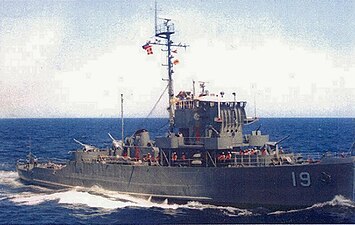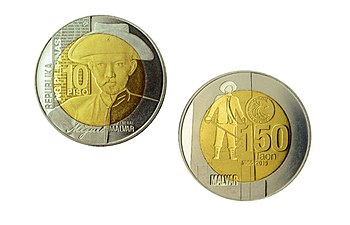Miguel Malvar
President of the Tagalog Republic ) | |
|---|---|
| Personal details | |
| Born | Miguel Malvar y Carpio September 27, 1865 General |
| Commands | Batangas Brigade (also known as the Malvar Brigade) |
| Battles/wars | |
Miguel Malvar y Carpio (September 27, 1865 – October 13, 1911) was a Filipino general who served during the Philippine Revolution and, subsequently, during the Philippine–American War. He assumed command of the Philippine revolutionary forces during the latter, following the capture of resistance leader Emilio Aguinaldo by the Americans in 1901.[1] According to some, he could have been listed as one of the presidents of the Philippines.[2] However, is not recognized as such by the Philippine government.
Early life
Malvar was born on September 27, 1865, in San Miguel, a barrio in Santo Tomas, Batangas, to Máximo Malvar (locally known as Capitán Imoy) and Tiburcia Carpio (locally known as Capitana Tibo). Malvar's family was well known in town not only for their wealth but for their generosity and diligence as well.[3]

For his education, Malvar attended the town school in Santo Tomas. He later attended a private school run by Father Valerio Malabanan
In 1891, Malvar married Paula Maloles, the daughter of the Capitán municipal of Santo Tomas, Don Ambrocio Maloles. Don Ambrocio was Malvar's successor as Capitán municipal.[3] Ulay, as she was locally known, bore Malvar thirteen children, but only eleven of them survived: Bernabe, Aurelia, Marciano, Maximo, Crispina, Mariquita, Luz Constancia, Miguel (Junior), Pablo, Paula, and Isabel.[5] Malvar had the habit of bringing his family with him as he went to battle during the Philippine Revolution and the Philippine–American War.[3]
Connections with Rizal
Malvar and his family had a friendship with
Philippine Revolution
Malvar was an original Katipunero, having joined the
After the Tejeros Convention, in which Aguinaldo won as president, Malvar opted to side with the Katipunan's Supremo, Andrés Bonifacio. In response to Malvar's support, Bonifacio gave them assistance in fighting their battles. Seeing the mutual relations between Malvar and Bonifacio, Aguinaldo decided to use his newly acquired position to put Batangas, as well as Malvar, under his jurisdiction.[3] Malvar was also threatened with punishment if he did not break ties with Bonifacio, but this threat was never implemented. Bonifacio and his brother Procopio were found guilty, despite insufficient evidence, and they were recommended to be executed. Aguinaldo 'issued a commutation of the sentence' to deportation or exile on May 8, 1897, but Pío del Pilar and Mariano Noriel, both former supporters of Bonifacio, persuaded Aguinaldo to withdraw the order for the sake of preserving unity. In this they were seconded by Mamerto Natividád and other bona fide supporters of Aguinaldo.[6] The Bonifacio brothers were murdered on May 10, 1897, in the mountains of Maragondon.[6][7]
After Bonifacio was murdered, the Spanish offensive resumed, now under
On November 1, 1897, the
Malvar, along with other generals like Mariano Trías, Paciano Rizal, Manuel Tinio, and Artemio Ricarte, as opposed to the pact, believing it was a ruse of the Spanish to get rid of the Revolution easily, and therefore resumed military offensives. Aguinaldo, seeing the stiff resistance of Malvar and his sympathizers, issued a circular ordering the revolutionary generals to stop fighting. On January 6, 1898, Malvar ceased his offensives.[3]
Philippine–American War
On May 19, 1898, Aguinaldo, aboard the American revenue cutter McCulloch, returned to the Philippines with 13 of his military staff. After four days, the first delivery of arms from Hong Kong arrived. It amounted to 2,000 rifles and 200,000 rounds of ammunition.[3] With Aguinaldo's return, the Filipinos, numbering around 12,000, who enlisted under the Spanish flag in the war against America defected to Aguinaldo's banner. By June, Philippine independence was declared in Kawit, Cavite and Manila found herself surrounded by Aguinaldo's troops. But on August 13, 1898, it was the Americans who captured Manila.[3]
On February 4, 1899, hostilities began between Americans and Filipinos. On February 7, Malvar was appointed second-in-command of General Trías, who was the overall commander of the Filipino forces in southern Luzon.[3] On February 23, General Antonio Luna needed Malvar and his unit to take part in a Filipino counterattack that was planned to regain ground lost earlier by Filipinos and capture Manila. However, the Filipino offensive collapsed mainly due to the insubordination of the Kawit Battalion.[13] During the following months, Malvar harassed American troops south of Manila as he and his 3,000-man brigade conducted offensives in Muntinlupa. By July 1899, the Americans under General Robert Hall captured Calamba, Laguna. With ten companies (around 2,000 men) of American troops in the town, Malvar unsuccessfully besieged Calamba from August to December 1899.[3]
On November 13, 1899, Aguinaldo disbanded the

Beginning January 1902, American General J. Franklin Bell took command of operations in Batangas and practiced scorched earth tactics that took a heavy toll on both guerrilla fighters and civilians alike. Malvar escaped American patrols by putting on disguises. So, as early as August 1901, the Americans released an exact description of Malvar's physical features.[3] According to the description given, Malvar was of dark complexion and stood around 5 feet 3 inches (1.60 m). He weighed about 145 pounds (66 kg) and wore a 5 or 6 size of shoes.[3] He surrendered to Bell on April 16, 1902[a] in Rosario, Batangas, mainly due to desertion of his top officers and to put an end to the sufferings of his countrymen.[3]
Later life and death
After the war, he refused any position offered to him in the American colonial government.[16] He died in Manila on October 13, 1911 due to kidney disease at the age of 46. He was buried in San Tomas in Batangas. [1]
Attributions as president
On September 18, 2007, Oriental Mindoro 1st district representative Rodolfo Valencia filed House Bill 2594, that declared Malvar as the second Philippine president, alleging that it is incorrect to consider Manuel L. Quezon as the second president of the Philippine Republic serving after Emilio Aguinaldo: "General Malvar took over the revolutionary government after General Emilio Aguinaldo, first president of the Republic, was captured on March 23, 1901, and [was] exiled in Hong Kong by the American colonial government—since he was next in command."[17] In October 2011, Vice President Jejomar Binay sought the help of historians in proclaiming revolutionary General Miguel Malvar as the rightful second president of the Philippines.[18]
Commemoration
- The Miguel Malvar class corvette, named after Malvar, is a ship class of patrol corvettes of the Philippine Navy, and are currently its oldest class of corvettes.
- Extra Mile Productions conducted the General Miguel Malvar Essay Writing Contest in commemoration of the 100th Death Anniversary of General Miguel Malvar.[19]
- Malvar, Batangas, a second class municipality in the Philippines, was named after him.
- Various streets were also named after him.
- In 2015, the National Historical Commission of the Philippines will open a museum in Santo Tomas to celebrate the 150th anniversary of Malvar's birthday on September 27.[20]
- In 2015, the Bangko Sentral ng Pilipinas (BSP) released the 10-peso commemorative coin in honor of Malvar's 150th birth anniversary.[21]
-
BRP Miguel Malvar (PS-19), the lead shipof the Miguel Malvar class corvette
-
Commemorative ₱10 coin released in 2015 by the Bangko Sentral ng Pilipinas in commemoration of Malvar's 150th birth anniversary. The obverse is shown on the left, while the reverse is on the right.
-
Malvar Shrine in Santo Tomas, Batangas
-
A postcard depicting Miguel Malvar
-
Miguel Malvar Monument in Malvar, Batangas
See also
- List of unofficial presidents of the Philippines
Notes
References
- ^ a b "General Miguel Malvar". Malacaňan Palace - Presidential Museum & Library. Archived from the original on May 23, 2022. Retrieved February 13, 2022.
- ^ "Miguel Malvar Was the Forgotten President of the Philippine Republic". Esquire. September 9, 2019.
- ^ a b c d e f g h i j k l m n o p q r s Abaya, Doroteo (1998). Miguel Malvar and the Philippine Revolution.
- ^ "Who is Valerio Malabanan?". thephilippinestoday.com. The Philippines Today. July 8, 2020. Retrieved March 29, 2021.
Among his stellar pupils were General Miguel Malvar, one of the last Filipino leaders to surrender in the Philippine-American War; Melchor Virrey, a known educator in Manila; & Apolinario Mabini, 1st head of the Aguinaldo cabinet and Prime Minister of the 1st Philippine Republic.
- ^ "Learn about Miguel's Children". www.malvar.net. Retrieved September 15, 2020.
- ^ a b Agoncillo 1990, pp. 180–181.
- ^ Constantino 1975, p. 191
- ^ a b Agoncillo 1990, p. 182
- ^ Biak na Bato Archived January 9, 2010, at the Wayback Machine, Newsflash.org.
- ^ Agoncillo 1990, p. 183
- ^ Joaquin, Nick (1990). Manila, My Manila. Vera Reyes Publishing.
- ^ Zaide 1994, p. 252
- ^ Jose, Vicencio. Rise and Fall of Antonio Luna. Solar Publishing Corporation. pp. 225–245.
- ^ Agoncillo, Teodoro (1960). Malolos: The Crisis of the Republic.
- ^ "Proclamation No. 173. s. 2002". Official Gazette of the Philippine Government. April 9, 2002.
- ^ Agpalo, R.E. (1992). Jose P. Laurel: National Leader and Political Philosopher. Jose P. Laurel Memorial Corporation. p. 90.
- ^ Lawmaker: History wrong on Gen. Malvar at the Wayback Machine (archived April 6, 2008). January 2, 2008. manilatimes.net (archived from the original on April 6, 2008).
- ^ "Binay seeks help from historians for overlooking Malvar as 2nd RP president". taga-ilog-news. October 24, 2011.
- ^ "General Miguel Malvar Essay Writing Contest". Retrieved September 23, 2012.
- ^ "At last, proper recognition for a revolutionary war hero - Yahoo News Philippines". Archived from the original on October 6, 2014. Retrieved October 6, 2014.
- ^ "BSP issues limited edition P10-Miguel Malvar coin". Rappler. December 21, 2015. Retrieved December 22, 2015.
Sources
- Abaya, Doroteo (1998), Miguel Malvar and the Philippine Revolution, Manila: Miguel Malvar (MM) Productions
- Agoncillo, Teodoro A. (1990), History of the Filipino people, R.P. Garcia, ISBN 978-971-8711-06-4
- ISBN 971-8958-00-2
- Zaide, Sonia M. (1994), The Philippines: A Unique Nation, All-Nations Publishing Co., ISBN 971-642-071-4
Further reading
- Zaide, Gregorio F. (1984). Philippine History and Government. National Bookstore Printing Press.
External links
- Miguel Malvar at www.geocities.com
- People and Organizations at www.geocities.com
- General Miguel Malvar at www.malvar.net
- Miguel Malvar at www.bibingka.com
- Philippine Heads of State Timeline at www.worldstatesmen.org





